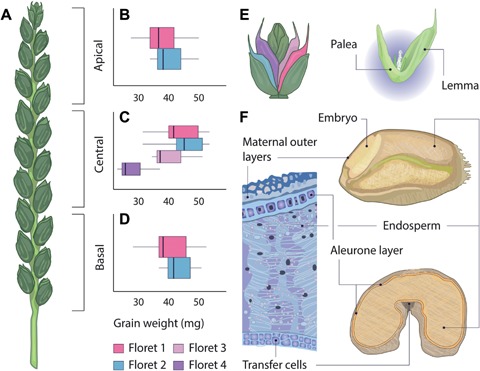Figure 1.

Grain weight across a wheat inflorescence (spike) and structure of mature grain The wheat inflorescence, known as the spike (A) consists of multiple spikelets, each comprising two outer glumes and multiple florets (E) that have the potential to hold grain. Each floret has two sheathing structures, the lemma and palea, which enclose the carpel and three stamens. Grain weight is non‐uniform across the spike, with spikelets in the apical (B) and basal (D) sections of the spike having smaller grains than the central spikelets (C). Grain weight is also non‐uniform within a single spikelet. At all spikelet positions, floret 2 contains the largest grain and the size of the grain from floret 1 is similar, but slightly smaller (B–D). Grains produced from floret 3 and 4 are smaller than those in florets 1 and 2 (C). F illustrates longitudinal (upper) and cross (lower) sections of a mature wheat grain, with a representation of the cell types found in a cross section (left). The aleurone, transfer cells and starchy endosperm are differentiated endosperm cell types and the maternal layers shown consist of the outer pericarp, cross cells and seed coat (top to bottom). Data for panels B–D from (Calderini and Ortiz‐Monasterio 2003; Liu et al. 2006; Lizana et al. 2010).
